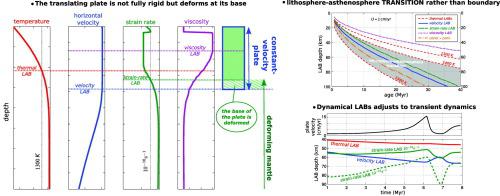Physics of the Earth and Planetary Interiors ( IF 2.3 ) Pub Date : 2021-04-03 , DOI: 10.1016/j.pepi.2021.106710 Fanny Garel , Catherine Thoraval

|
While the lateral limits of tectonic plates are well mapped by seismicity, the bottom boundary of the lithosphere, the uppermost rigid layer of the Earth comprising both crust and shallow mantle, remains elusive. The lithosphere is usually viewed as consisting of cold, rigid, internally undeformed blocks that translate coherently. The base of the lithosphere, designated as the lithosphere-asthenosphere boundary (LAB), may thus be characterised by different physical fields: temperature, viscosity, strain rate and velocity. The LABs as defined by these different fields are investigated here using thermo-mechanical models of plate and upper mantle dynamics, either in a transient subduction or in a steady-state plate-driven set-up. Mantle material is modelled as homogeneous in composition with a viscosity that depends on temperature, pressure and strain rate. In such a system, the thermo-mechanical transition between lithosphere and asthenosphere occurs over a finite depth interval in temperature, strain rate and velocity. We propose that the most useful dynamical LAB is defined as the base of a “constant-velocity” plate (i.e. the material translating at constant horizontal velocity). The bottom part of this plate deforms at strain rates comparable to those in the underlying asthenosphere mantle: the translating block is not fully rigid. Thermal structure exerts a major control on this dynamical LAB, which deepens with increasing plate age. However, the surface plate velocity, the asthenospheric flow geometry and magnitude also influence the depth of the dynamical LAB, as well as the thickness of the deformed region at the base of the constant-velocity plate. The mechanical transitions from lithosphere to asthenosphere adjust when mantle dynamics evolves. The dynamical and thermo-mechanical LABs occur within a thermal lithosphere-asthenophere gradual transition, similar to the one imaged by geophysical proxies. The concept of a constant-velocity plate can be extended to a constant-velocity subducting slab, which also deforms at its borders and drags the surrounding mantle. This framework is relevant to quantify mass transport within the Earth's mantle.
中文翻译:

岩石圈作为恒速板块:在均一的地幔物质中追踪动态LAB
虽然构造板块的横向界限通过地震活动得到了很好的映射,但岩石圈的底部边界(包括地壳和浅地幔的地球的最上层刚性层)仍然难以捉摸。通常认为岩石圈是由冷的,刚性的,内部未变形的块组成的,这些块连贯地平移。因此,岩石圈的底部被称为岩石圈-软流圈边界(LAB),其特征可能在于不同的物理场:温度,粘度,应变率和速度。在瞬态俯冲或稳态板驱动装置中,本文利用板和上地幔动力学的热力学模型研究了由这些不同领域定义的LAB。地幔材料被建模为成分均一,其粘度取决于温度,压力和应变率。在这样的系统中,岩石圈和软流圈之间的热机械转变发生在温度,应变速率和速度的有限深度间隔内。我们建议将最有用的动力学LAB定义为“恒定速度”板的基础(即,材料以恒定的水平速度平移)。该板的底部以与下面的软流圈地幔相当的应变率变形:平移块不是完全刚性的。热结构对该动态LAB进行了主要控制,该动态LAB随着板龄的增加而加深。但是,表面板的速度,软流圈的几何形状和大小也会影响动态LAB的深度,以及等速板底部变形区域的厚度。当地幔动力学演化时,从岩石圈到软流圈的机械过渡就会调整。动态和热力学LAB发生在热岩石圈-斜向渐进过渡中,类似于地球物理代理所成像的过渡。等速板的概念可以扩展到等速俯冲平板,该平板也将在其边界变形并拖曳周围的地幔。该框架与量化地球地幔内的物质传输有关。它的边界也会变形并拖曳周围的地幔。该框架与量化地球地幔内的物质传输有关。它的边界也会变形并拖曳周围的地幔。该框架与量化地球地幔内的物质传输有关。


























 京公网安备 11010802027423号
京公网安备 11010802027423号